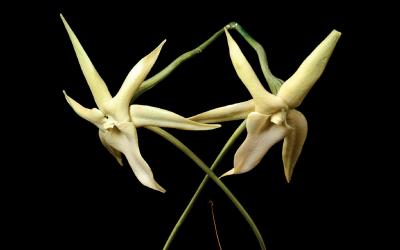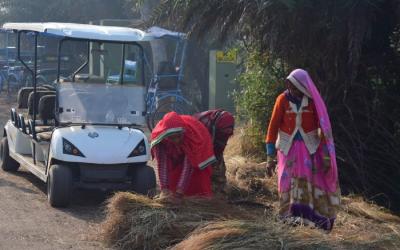According to some estimates, up to 17% of India’s landmass is classified as being covered with grasslands. The grasslands of India form a savanna – semi-arid grassland system that stretches across large swathes of India, including Gujarat, Maharashtra, Andhra Pradesh, and Karnataka. In addition, the Ladakh and trans-Himalayan region situated above 3,500 m above sea level are also home to high altitude dry grasslands. The savanna grasslands spread across peninsular India harbors unique biodiversity, particularly of mammals such as the wolf, blackbuck, and rare birds such as the Great Indian Bustard and the Bengal Florican.
The savanna grasslands also support several agro-pastoral communities such as the Konars of Tamil Nadu, which depend on these rangelands for their livelihoods. Other pastoral communities of India include the Maldharis of Gujarat and Rajasthan, the Dhangars of Maharashtra, and the Kurubas of Karnataka.
However, grasslands in India have undergone a sea of transformation in the past century. Often classified as wastelands, they are rapidly disappearing throughout their range, and are under severe degradation from development projects, conversion to agriculture, urbanization, linear intrusions like highways and power transmission lines, invasion by Prosopis juliflora (an invasive plant of South American origin that has proliferated widely across India), and planting of trees.
Moreover, on a global scale, grasslands are increasingly being affected by climate change, desertification and degradation. Further aggravating matters, policymakers have categorized grasslands as “wastelands,” which has ensured a lack of protection and consequently exposed them to easy conversion and destruction.
The grasslands of Tirunelveli and Thoothukudi are scattered across the plains that begin from the foothills of the southern Western Ghats, which form the western spine of the Tamil Nadu straddling the border with Kerala. The plains themselves are semi-arid and irrigated by canals carrying water from the Tamiraparani and Manimutharu rivers that originate in the Ghats.
Konar shepherds migrate along with their sheep following the availability of grass for 5 to 6 months every year. In the summer months, they graze their herds in the grasslands around Parathipadu, Radhapuram and Peikulam, grazing in commons such as the Nellaiappar temple lands, and in farm fallows which have paddy residue. After the monsoons, they head north towards Mundanthurai and Ambasamudram following the release of water from the dams to the rivers emerging from the Western Ghats, where there is fresh grass available once again. This seasonal migration forms part of the traditional lifestyle of the Konars and allows the grasslands to recover from grazing in the monsoon months.
However, the grasslands have experienced massive socio-ecological changes over the past few decades that have impacted the Konars and other communities dependent on the grasslands. The expansion of towns and cities in southern Tamil Nadu has resulted in a majority of the grasslands where Konars used to graze and pen their sheep closer to their home grounds, being divided into private enclosures for housing projects, many of which have been purchased by farmers from neighbouring Kerala.
Grasslands have also been invaded by Prosopis juliflora which now covers a significant proportion of them. Prosopis is especially ubiquitous around tanks and tank beds. Eucalyptus plantations have been raised on these grasslands by paper industries, particularly by the Tamil Nadu Papers Limited (TNPL), which raises plantations of pulp yielding species.
Additionally, the construction of a canal linking the Tamirabarani, Karunemiyar and Nambiyar rivers has eaten into a significant portion of the grasslands. As a result of this, there is a very drastic and visible decrease in the extent of these grasslands and consequently the grazing pastures used by the Konars.
Consequently, a study carried out by the Ashoka Trust for Research in Ecology and the Environment (ATREE) in 2017 on the spatial changes in grasslands used by the Konar community reveals that built-up land increased by 278% between 2000 and 2014, and was particularly concentrated around the district capital of Tirunelveli and along the Tamirabarani river. This expansion of built-up areas has impacted pastoral lands.
The study finds that the significance of these grazing lands for the Konars and other pastoral communities is enormous. Such grazing grounds can support unique biota not found in any other ecosystem, and their disappearance could mean not just loss of this biodiversity, but also the loss of livelihoods of Konars and other pastoralists. Put together, there seems to be an alarming and rapid transition from a land-use pattern, one that permitted agro-silvo-pastoral production system to one that is highly specialized, resulting in not just loss of biodiversity but also livelihoods of these communities. However, what remains unknown is how ecosystems such as grasslands can feed into agriculture and allied primary production livelihoods such as pastoralism.
An understanding of this contribution would lead not only to greater appreciation and thereby the conservation and sustainable use of biodiversity but also the livelihoods of these communities. Towards this end, the Government of India, under the aegis of the Prime Minister’s Science, Technology and Innovation Advisory Council has started the National Mission on Biodiversity and Human Well-being (NMBHWB). One of the components under the Mission relates to biodiversity, agriculture, food and livelihood security.
The Mission aims to promote the sustainable use of biodiversity in ensuring food and nutritional security: enhancing agricultural productivity and augmenting incomes of rural households by incorporating biodiversity into agriculture. The Mission involves various government and non-governmental agencies, including various bureaus under the Indian Council of Agricultural Research (ICAR), the National Biodiversity Authority, state agricultural universities and research institutions. The Mission also focuses on issues related to the maintenance of commons necessary for conserving biodiversity and towards supporting agro-pastoralist livelihoods.




